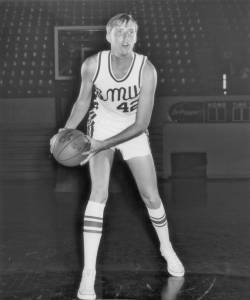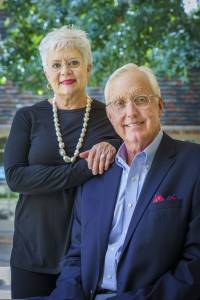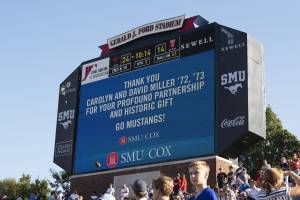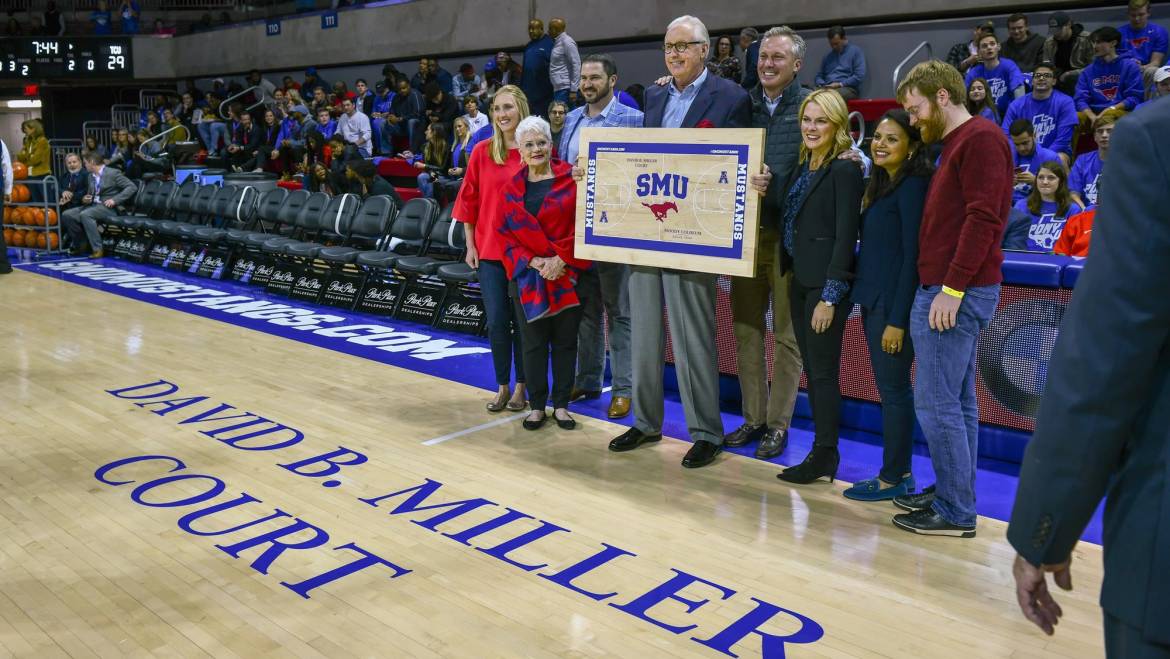Six-foot-eight David Miller played varsity basketball for Southern Methodist University from 1970 to 1972. Not a star by any stretch of the imagination (9.1 points and 5.8 rebounds per game), he nevertheless contributed to his team winning a share of the 1972 Southwest Conference championship. I would have seen him twice that season, when I was a freshman at UT—at Gregory Gym and in Waco where the Longhorns and Mustangs had a one-game playoff; Miller’s athletic career ended when the orange and white took a hard-fought 91-89 overtime victory, advancing to the NCAA tourney.
He graduated and stayed on the Hilltop another year, earning a master’s degree in business administration. Perhaps you have heard the phrase “look British but think Yiddish.” Well, that seems to describe Miller who has a nose for “deals,” always buying low and selling high. His first job, at Republic National Bank in Dallas, was the last time he had a boss. By 1981, he had founded a Denver-based oil and gas company called Maze Exploration. Eight years later, he created EnCap, a private equity firm also specializing in oil and gas. With headquarters in both Dallas and Houston, it has grown into the eighth largest company of its kind in the world.
Miller sits on the boards of numerous entities, including the SMU Board of Trustees; he has served as vice-chairman since 2011. His wealth has been estimated conservatively at $286 million—not bad for a guy from Richland, a little town in Navarro County. Everything I have read about this man indicates that his fortune has been fairly earned. Furthermore, he has not hoarded it. He and his wife Carolyn set up a foundation that allows them to be active and generous philanthropists. The key recipient of Miller’s largesse has been SMU. In the late 1970s, he began making donations for scholarships and professorships. More recently and more publicly, he gave $17.5 million to renovate and expand Moody Coliseum—the very arena where he had once played for Bob Prewitt’s Ponies. The school thanked him in many ways. In 2018, a street on campus became Miller Boulevard and the court at Moody Coliseum was named in his honor. All of this was presented in glowing SMU press releases, the student newspaper, the alumni magazine, the Dallas Morning News and elsewhere. 
He had given SMU about $51 million until October 2019 at which time he almost doubled that. Miller made a $50 million gift to the Cox School of Business for facilities, scholarships and a modernized curriculum. It was the largest donation in SMU history, and expressions of gratitude were again effusive. He was recognized during halftime of a home football game, and school president R. Gerald Turner hailed him as the epitome of an SMU alum.
To be perfectly clear, I do not begrudge Miller for making large, albeit tax-deductible, donations to SMU. Nevertheless, I find the business of the university naming the Moody Coliseum court after him a bit distasteful. His ego is undoubtedly flattered by this. I make donations too—on a far smaller scale—but I do not call attention to them. Why seek praise for performing a kind act? Hey, I thought virtue was its own reward. Since SMU is ostensibly a Christian school, I would direct Miller’s attention to the Sermon on the Mount in which Jesus said that alms-giving should be done quietly and discreetly.
SMU has an endowment of $1.6 billion, but like virtually every other institution of higher education it is constantly asking for more. The fundraising (favored euphemism: “development”) never ends. Gregg Easterbrook used to write a column for ESPN called “Tuesday Morning Quarterback.” While it was mostly about football, he often veered into social and political matters. Easterbrook constantly railed against people like Miller doing what he has done with SMU. He contended that giving money to a school that already has plenty of it is obscene. Easterbrook advocated making donations to smaller schools, poorer schools, schools without shiny pedigrees. He said, and I agree with him fully, that donors can get more bang for the buck by  sending money there rather than to the Ivy League, Duke, Stanford and so on. He mentioned Spelman, Beloit, Berea, Millsaps and Randolph-Macon as colleges that are in more urgent need of support. And financial donations should not be restricted to American colleges. Easterbrook wrote in all seriousness that the University of Dar es Salaam in Tanzania could use some benefactors. No less deserving, in my view, are Negros Oriental State University in the Philippines, American University in Paraguay and the University of the West Indies in Jamaica.
sending money there rather than to the Ivy League, Duke, Stanford and so on. He mentioned Spelman, Beloit, Berea, Millsaps and Randolph-Macon as colleges that are in more urgent need of support. And financial donations should not be restricted to American colleges. Easterbrook wrote in all seriousness that the University of Dar es Salaam in Tanzania could use some benefactors. No less deserving, in my view, are Negros Oriental State University in the Philippines, American University in Paraguay and the University of the West Indies in Jamaica.
Miller, 69, is free to use his money however he sees fit. By dint of intelligence and hard work, he has forged quite a life and legacy. I admire and respect him for donating $101 million (and counting) to his alma mater. Anyway, this is not really so over-the-top since other people have given more. Miller’s gifts are small potatoes compared to the $1.8 billion from Michael R. Bloomberg to Johns Hopkins in 2018, the $750 million from Stewart Resnick to Cal Tech in 2019, the $500 million from Phil Knight to Oregon in 2016, the $400 million from John W. Kluge to Columbia in 2007, the $350 million from Stephen A. Schwarzman to MIT in 2018 and the $300 million from William H. Scheide to Princeton in 2015, to list but a few. And SMU’s $1.6 billion endowment looks tiny next to Harvard’s $41 billion, Texas’ $31 billion, Yale’s $29 billion, Stanford’s and Princeton’s $26 billion each, MIT’s $16 billion, Pennsylvania’s $14 billion, Texas A&M’s $13 billion, and Michigan’s and Northwestern’s $12 billion each.


9 Comments
I NEVER understood giving money to universities as a charity. I have never donated a penny to Texas State. I loved the school, ran track and cross country for them, but I paid for a service which they provided. After that, we are both done. I don’t send checks to Walmart after buying something because I liked shopping there. Many universities are awash in money. Professors are paid very well, sometimes for only teaching one class. If a school is working on a cure for cancer, I follow that, but most of the money just goes for athletics, etc.
I’m with you, Kenny. The U of T has learned that I am not a donor or potential donor. The “development” friends of whom I spoke say it is not so simple as it looks, especially with the Texas Legislature having cut money for higher education.
With that kind of endowment, you’d expect that the tuition rates would be adjusted. I understand that SMU’s tuition is now the highest in the state. Can you confirm? Also, when is enough endowment enough to make the tuition comparable to other schools. I think Texas A&M is $20,000 per year and SMU is $80,000 for 30 hours (two 15 hour semesters).
Gary, I got those figures from the Chronicle of Higher Education, so I assume they are reliable. I may send this story to Miller. What can he do? It’s not libelous or an invasion of his privacy. I think I will….
Universities are like the medieval churches which were very wealthy for the time, just like the Universities are now. I find it outrageous thatUniversities have huge endowments and yet most students graduating now have gone deep into debt to get an often useless degree. Having something named for yourself is big business. Our small local hospital has a price list of how much one has to donate to get something named after them, there’s a price for a waiting room, a price for a wing of the hospital etc. It’s all perfectly legal and ethical, but also very crass.
Wow, that situation with your local hospital….it may be legal, but it doesn’t sound too ethical to me. Your comparison of modern universities with medieval churches is excellent. I just wish I had used it in this story, haha! I have sent it to Mr. Miller in Dallas. Will he respond? And if so, how?
Richard:
I agree with you – giving to your alma mater should be done quietly and discreetly. And there are so many colleges and hospitals that need donations to stay operational.
Thanks,
Rex Lardner
Yes, but even Harvard with its $41 B endowment, people are rushing to give it more. The whole thing perplexes me. Joe Jamail is one of UT’s biggest donors, and there are no fewer than three statues of him on campus. Big, strong man but a pathetic, little ego.
One friend commented by e-mail that nobody would give such money without an ego-confirming payback like “David Miller Court.” Not so. Some people give anonymously. Three examples are $360 million to Rensselaer Polytechnic Institute in 2001, $200 million to Baylor University in 2010 and $150 million to the University of California at San Francisco in 2007.
Add Comment